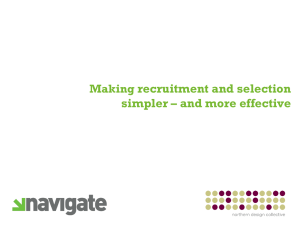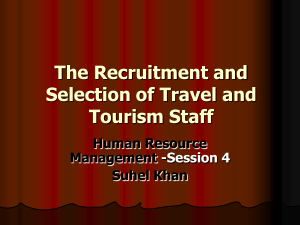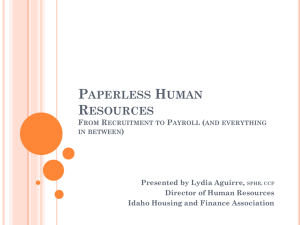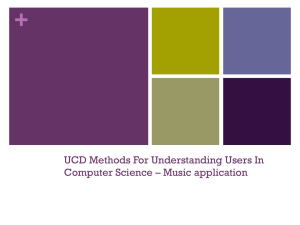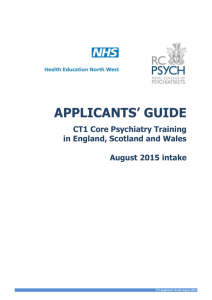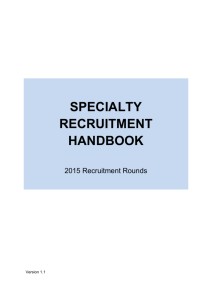chapter5
advertisement
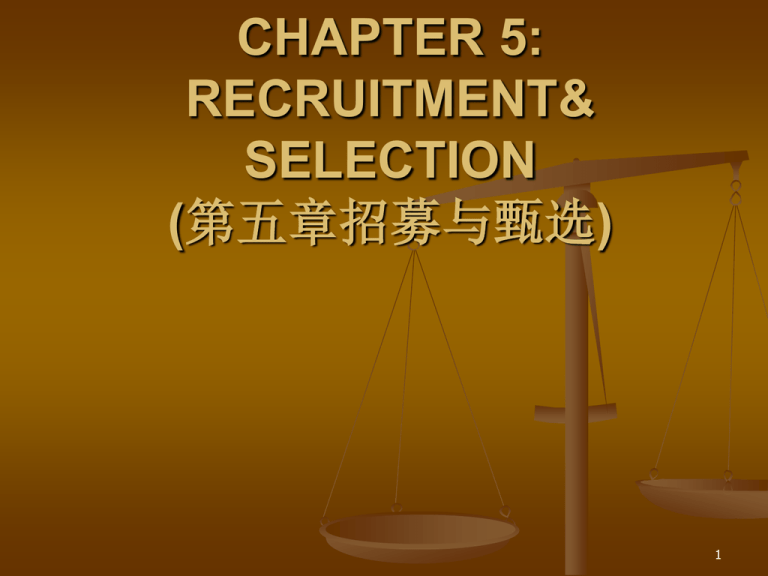
CHAPTER 5: RECRUITMENT& SELECTION (第五章招募与甄选) 1 MAIN CONTENTS AN INTRODUCTION TO EMPLOYEE RECRUITMENT RECRUITMENT PROCESS RECRUITMENT SOURCES SELECTION 2 一、AN INTRODUCTION TO EMPLOYEE RECRUITMENT(第一节招 聘概述) 1.Definition 2.Reasons for Employee Recruitment 3.Goal of Employee Recruitment 4.Aim of Employee Recruitment 5.Principles for Employee Recruitment 3 1.Definition Recruitment is defined as any practice or activity carried on by the organization with the primary purpose of identifying and attracting potential employees. 4 2.Reasons for Employee Recruitment New branch to be established New business to be enlarged Unresonable employee configurations Vacancies Downsizing 5 3. Goal of Employee Recruitment To ensure that the organization has a number of reasonably qualified applicants Not simply to generate large numbers of applicants Not to finely discriminate among reasonably qualified applicants 6 4. Aim of Employee Recruitment The aim of recruitment is to have the right people at the right time for the right place. 7 5. Principles for Employee Recruitment Selecting People according to the requirements of jobs(因事择人原则) Internal recruitment must be put before the external recruitment(先内后外原则) Open and Transparent(公开透明原则) Fair Competition(公平竞争原则) Choosing the best one among all applicants and observing his quality and ability (量才择 优原则) Abiding by the relative law, decree and 8 policy of our country(遵守相关法律原则) 二、RECRUITMENT PROCESS(第二节 招聘程序) Enlistment(招募) Selection(甄选) Employment (录用) Appraisal(评估) 9 三、RECRUITMENT SOURCES (第三节 招聘渠道) 1. INTERNAL SOURCES(内部招聘渠道) 2.EXTERNALSOURCES(外部招聘渠道) 10 INTERNAL SOURCES(内部招聘渠 道) JOB POSTING(工作张榜法/布告法 ) In the typical job posting system, the details of a job vacancy notice is posted in the internal notice board and Website to attract the internal employees. 11 INTERNAL SOURCES(内部招聘渠 道) COMPUTERIZED CAREER PROGRESSION SYSTEMS (档案法) The information regarding the job skills of each employee can be stored in filing cabinet or the HPIS. When a job becomes vacant, HRD or the computer search its skills file in order to identify employees having the requisite qualifications for the vacant job. 12 INTERNAL SOURCES(内部招聘渠 道) RECOMMENDATIONS (推荐法) supervisor, department or employees can recommend internal candidates if they are asked to nominate one or more people for consideration 13 Internal (内招) Advantage Disadvantage Encouraging morale Be familiar with the organization and easy to adapt to the job Better assessment of abilities Achieving right recruitment Low cost Inbreeding “Political” infighting for promotions Limited sources training 14 EXTERNALSOURCES(外部招聘渠 道) EMPLOYEE REFERRALS (员工推荐法) When a position becomes vacant, firms often use employee referrals to fill them. 15 EXTERNALSOURCES(外部招聘渠 道) HELP-WANTED ADVERTISEMENTS (广告招聘) When some openings occur, we can convey the message to potential applicants through newspaper, magazines, broadcasting and TV so as to attract them to apply. 16 EXTERNALSOURCES(外部招聘渠 道) EMPLOYMENT AGENCIES(职业中介) EMPLOYMENT AGENCIS is a special kind of recruitment method with which the organization entrusts career intermediaries with the responsibilities to search and initially select the required applicants 17 EXTERNALSOURCES(外部招聘 渠道) JOB HEADHUNTER(猎头公司) Job Headhunters are a special kind of career intermediaries that are use to hunting and recruiting high managerial people and special technical personnel Cost:25%-33%. 18 EXTERNALSOURCES(外部招聘渠 道) JOB FAIRS (招聘会) Job fair can either be special one(专 场) or non-special one(非专场). Since a group of firms sponsors a meeting or exhibition at which each has a booth to publicize jobs available, Job fairs may attract a lot of applicants to come. 19 EXTERNALSOURCES(外部招聘渠 道) COLLEGE RECRUITING(校园招聘) In college recruiting, the organization sends an employee, usually called a recruiter, to a campus to interview candidates Coinciding with the visit, brochures and other literature about the organization as well as application form are often distributed. 20 EXTERNALSOURCES(外部招聘渠 道) INTERNET RECRUITING(网络招聘) HRD can release vacancies through its home page or a variety of web sites where applicants can submit their resumes and potential employers can check for qualified applicants. 51job.com , zhaopin.com , chinahr.Com, employchina.com 21 SOURCES PROS&CONS EMPLOYEE REFERRALS 可靠性强,因为推荐人对被推荐人有一定的了 解;成功率高,因为被推荐人对公司有一定的 了解,对工作的期望较实际;缩短招聘时间, 降低了招聘成本。 INTERNET RECRUITING 人才储量丰富;查询筛选功能强;无地域限制, 不受时间、空间和地域的限制;成本低 COLLEGE RECRUITING 针对性强、可以选择学校、专选择专业来进行 招聘,根据企业需要进行人才储备。 JOB FAIRS 面对面;筛选迅速;针对性强;但受地域限制 性强。 JOB 招聘过程隐蔽性好,保密性好,专业化管理程 HEADHUNTER 度非常高;太贵 HELPWANTED ADVERTISEM 覆盖面和影响力大,时效性强,可同时宣传公 司。传播的范围广,可吸引众多的应聘者,企 22 业选择的余地大;较贵 External (外招) Advantage To Disdvantage May have a big pool of applicants “New blood” will bring new thoughts and new ways of doing things To save training investment not select someone who will “fit” the job or organization Be unfamiliar with the organization and uneasy to adapt to the job May cause morale problems for internal candidates not selected23 四、SELECTION (第四节 甄选) 1.Definition 2.Selection Process 24 Selection : Selection is the process by which an organization chooses from a list of applicants the person and persons who best meet the selection criteria and then have him and them in the right place. 25 Selection process(甄选流程) Application Form Appraisal Pencil and Paper Test Psychological Test Physical check-up Background-checks Situational Simulation Interview 26 1.Application Form Qualification evaluation (资格审查) HRD approves each individual‘s application form and chooses those who match the recruiting requirements and then pass them on to the line department. Initial Screening(筛选): The line department selects those who better meet the selection criteria from the list of applicants. 27 2.Paper&Pencil Tests Paper & Pencil Test refers to testing applicants’ knowledge and skills or ability ,including both general and specialized. The general knowledge and skills include literacy knowledge(文化知识),verbal comprehend and numeral ability, reasoning or memory ability . The specialized knowledge and ability refer to the knowledge such as financial, accounting or management which is related to the job, and interpersonal and observation skills etc,. 28 3. Psychological Tests IQ Test (智力测试, Binet和Simon,西 比量表,吴天敏的中国-比奈量表, 1983 ) IQ = Psychological age除以actual agex100, Personality Test Personality refers to a person’s attitude, interests ,motives and values. 29 自陈量表法 The Cattell PF(卡特尔16种个性特征测试) Minnesota Multiphase personality Inventory(明尼苏达多重人格测试,哈撒 韦和麦金利 ) 投射法 Ink marks Test(墨迹测试) Thematic Apperception Test(主题统觉 测试) 30 4. Situational Simulation A. The in-basket Test(公文处理) Job candidates are asked to respond to documents, memos, reports, incoming calls ,letters in the inbasket of the simulated job he or she is to take over. Each person is observed his or her ability of judging the order of importance and urgency. 31 B. The leaderless group discussion(无 领导小组讨论) A leaderless group is given a discussion question and told to arrived at a group decision. Each person is observed his or her interpersonal skills, leadership ability and individual influence. 32 C. Oral Presentation (即席发言法) A participant’s communication skills, persuasiveness are evaluated by having the person make oral presentation of the assigned topic after a few minutes of preparation. 33 D. Role playing(角色扮演法) A participant’s problem-solving skills are evaluated by having the person play the assigned role to handle daily management affairs. 34 5. Interview (面试) Purpose of Interview (面试的目的) Type of Interview (面试方式) Content of Interview(面试内容) 35 Purpose of Interview (面试的目的) 1.Assessing whether the applicant fits to the job 2.Propagating the organization 36 Type of Interview (面试方式) STRUCTURED &UNSTRUCTURED INTERVIEWS (结构式与非结构式面试,从问题 的设计划分) STRESS INTERVIEW /BEHAVIORAL INTERVIEW (压力面试/行为面试,从面试目的划 分) Situational INTERVIEW/ JRI(情景面试/与工 作相关面试,从面试的内容划分 ) One to one / more to one continuous / once(一对一、多对一;连续性和一次性,从面试 的控制划分 ) 37 STRUCTURED INTERVIEW (结构式面试) A list of questions are designed & prepared in advance. interviewees will be interviewed in strict accordance with the questions or topics prepared beforehand. 38 UNSTRUCTURED INTERVIEWS (非结构式面 试) Interviewers ask questions as they come to mind without any preparation beforehand. There is generally no set format to follow. 39 STRESS INTERVIEW (压力面试) A Stress Interview is a special type of selection interview in which the applicant is made uncomfortable by a series of sometime rude or unexpected questions so as to test and identify the applicants’ with reaction ability, stress of tolerance, feeling- control ability. 40 BEHAVIORAL INTERVIEW (行为面试) In a behavioral interview a situation is described and interviewees are asked how they have behaved in the past in such a situation so as to judge and predict their future performance. 41 Content of Interview(面试内容) Appearance & Attainments (仪表与修 养)of candidates Working experience, knowledge and ability of candidates Motives(动机) Interpersonal &communication skill Analyzing & judging abilities 42 6.Reference Checks (背景调查) 7.Physical Examinations (体检) 43 一份好的简历应包括哪些内容 自然情况(姓名、性别、出生年月日、出生地 点、身高、体重、健康状况) 学历和工作经历(学位、专业、毕业院校、其 它技能、原工作单位名称、曾任职务、任职时 间) 主要业绩和获奖情况 学历和其他专业技能证书复印件(英语、计算 机、会计证、驾驶证) 联络方式 推荐信复印件 44 学生去面试时应注意哪些问题 一、了解熟悉应聘企业的基本情况(规模、产品、 人数、文化及在行业的地位) 二、准时到达,适当穿着和热忱礼貌的态度,为 自己制造良好的第一印象) 三、对考官提出的第一第二正式问题应简单回答, 留下时间让他表达自己对你的期望 四、尽量展示自己的过去,以过去为荣 五、在回答复杂问题前应稍微思考,理解问题实 质后,有条理有逻辑性地表达自己的意见 六、回答问题过程中保持适度的微笑,身体语言 不要太大 45 七、尽可能多经历一些面试,积累面试经验


